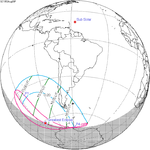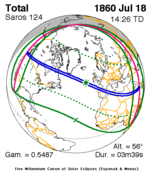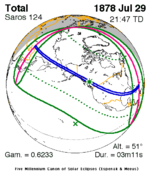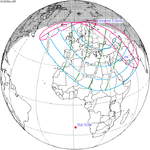Solar eclipse of September 12, 1950
| Solar eclipse of September 12, 1950 | |
|---|---|
| Type of eclipse | |
| Nature | Total |
| Gamma | 0.8903 |
| Magnitude | 1.0182 |
| Maximum eclipse | |
| Duration | 74 s (1 min 14 s) |
| Coordinates | 54°48′N 172°18′E / 54.8°N 172.3°E |
| Max. width of band | 134 km (83 mi) |
| Times (UTC) | |
| Greatest eclipse | 3:38:47 |
| References | |
| Saros | 124 (51 of 73) |
| Catalog # (SE5000) | 9399 |
A total solar eclipse occurred on September 12, 1950. A solar eclipse occurs when the Moon passes between Earth and the Sun, thereby totally or partly obscuring the image of the Sun for a viewer on Earth. A total solar eclipse occurs when the Moon's apparent diameter is larger than the Sun's, blocking all direct sunlight, turning day into darkness. Totality occurs in a narrow path across Earth's surface, with the partial solar eclipse visible over a surrounding region thousands of kilometres wide. Totality was visible from eastern Soviet Union (today's Russia) and the whole Semichi Islands in Alaska.
Related eclipses[edit]
Solar eclipses of 1950–1953[edit]
This eclipse is a member of a semester series. An eclipse in a semester series of solar eclipses repeats approximately every 177 days and 4 hours (a semester) at alternating nodes of the Moon's orbit.[1]
| Solar eclipse series sets from 1950 to 1953 | ||||||
|---|---|---|---|---|---|---|
| Ascending node | Descending node | |||||
| Saros | Map | Saros | Map | |||
| 119 |  1950 March 18 Annular (non-central) |
124 |  1950 September 12 Total | |||
| 129 |  1951 March 7 Annular |
134 |  1951 September 1 Annular | |||
| 139 |  1952 February 25 Total |
144 |  1952 August 20 Annular | |||
| 149 |  1953 February 14 Partial |
154 |  1953 August 9 Partial | |||
| Solar eclipse of July 11, 1953 belongs to the next lunar year set | ||||||
Saros 124[edit]
Solar saros 124, repeating every about 18 years and 11 days, contains 73 events. The series started with partial solar eclipse on March 6, 1049. It contains total eclipses from June 12, 1211, to September 22, 1968, and a hybrid solar eclipse on October 3, 1986. The series ends at member 73 as a partial eclipse on May 11, 2347. The longest total eclipse occurred on May 3, 1734, at 5 minutes and 46 seconds.[2]
| Series members 43–59 occur between 1801 and 2100: | ||
|---|---|---|
| 43 | 44 | 45 |
 June 16, 1806 |
 June 26, 1824 |
 July 8, 1842 |
| 46 | 47 | 48 |
 July 18, 1860 |
 July 29, 1878 |
 August 9, 1896 |
| 49 | 50 | 51 |
 August 21, 1914 |
 August 31, 1932 |
 September 12, 1950 |
| 52 | 53 | 54 |
 September 22, 1968 |
 October 3, 1986 |
 October 14, 2004 |
| 55 | 56 | 57 |
 October 25, 2022 |
 November 4, 2040 |
 November 16, 2058 |
| 58 | 59 | |
 November 26, 2076 |
 December 7, 2094 | |
Metonic series[edit]
The metonic series repeats eclipses every 19 years (6939.69 days), lasting about 5 cycles. Eclipses occur in nearly the same calendar date. In addition, the octon subseries repeats 1/5 of that or every 3.8 years (1387.94 days). All eclipses in this table occur at the Moon's descending node.
| 22 eclipse events between September 12, 1931 and July 1, 2011. | ||||
|---|---|---|---|---|
| September 11-12 | June 30-July 1 | April 17-19 | February 4-5 | November 22-23 |
| 114 | 116 | 118 | 120 | 122 |
 September 12, 1931 |
 June 30, 1935 |
 April 19, 1939 |
 February 4, 1943 |
 November 23, 1946 |
| 124 | 126 | 128 | 130 | 132 |
 September 12, 1950 |
 June 30, 1954 |
 April 19, 1958 |
 February 5, 1962 |
 November 23, 1965 |
| 134 | 136 | 138 | 140 | 142 |
 September 11, 1969 |
 June 30, 1973 |
 April 18, 1977 |
 February 4, 1981 |
 November 22, 1984 |
| 144 | 146 | 148 | 150 | 152 |
 September 11, 1988 |
 June 30, 1992 |
 April 17, 1996 |
 February 5, 2000 |
 November 23, 2003 |
| 154 | 156 | |||
 September 11, 2007 |
 July 1, 2011 | |||
Notes[edit]
- ^ van Gent, R.H. "Solar- and Lunar-Eclipse Predictions from Antiquity to the Present". A Catalogue of Eclipse Cycles. Utrecht University. Retrieved 6 October 2018.
- ^ Saros Series Catalog of Solar Eclipses NASA Eclipse Web Site.
References[edit]
- Earth visibility chart and eclipse statistics Eclipse Predictions by Fred Espenak, NASA/GSFC




